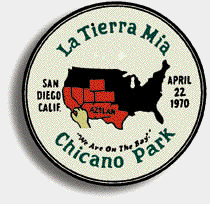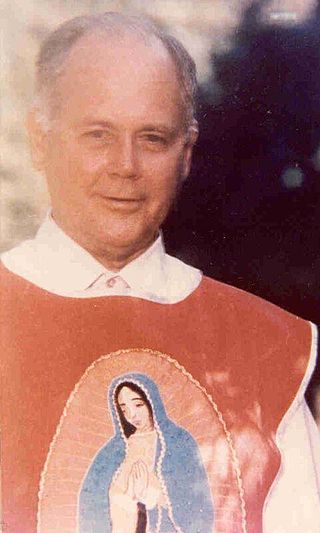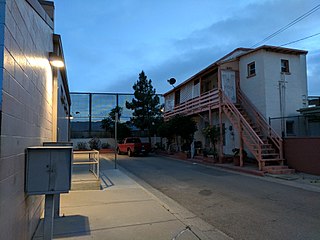
Ciudad Juárez, commonly referred to as just Juárez, is the most populous city in the Mexican state of Chihuahua. It was known until 1888 as El Paso del Norte. Juárez is the seat of the Juárez Municipality with an estimated population of 2.5 million people. It lies on the Rio Grande river, south of El Paso, Texas, United States. Together with the surrounding areas, the cities form El Paso–Juárez, the second largest binational metropolitan area on the Mexico–U.S. border, with a combined population of over 3.4 million people.

Las Cruces is the second-most populous city in the U.S. state of New Mexico and the seat of Doña Ana County. As of the 2020 census the population was 111,385. Las Cruces is the most populous city in both Doña Ana County and southern New Mexico. The Las Cruces metropolitan area had an estimated population of 213,849 in 2017. It is the principal city of a metropolitan statistical area which encompasses all of Doña Ana County and is part of the larger El Paso–Las Cruces combined statistical area with a population of 1,088,420 making it the 56th largest combined statistical area in the United States.

El Paso is a city in and the county seat of El Paso County, Texas, United States. The 2020 population of the city from the U.S. Census Bureau was 678,815, making it the 22nd-most populous city in the U.S., the most populous city in West Texas, and the sixth-most populous city in Texas. The city has the largest Hispanic population share of main cities in the U.S. at 81%. Its metropolitan statistical area covers all of El Paso and Hudspeth counties in Texas, and had a population of 868,859 in 2020.
Barrio is a Spanish word that means "quarter" or "neighborhood". In the modern Spanish language, it is generally defined as each area of a city, usually delimited by functional, social, architectural or morphological features. In Spain, several Latin American countries and the Philippines, the term may also be used to officially denote a division of a municipality. Barrio is an arabism.

Downtown El Paso is the central business district of El Paso, Texas.

Second Ward is a historical political district ward in the East End community in Houston, Texas. It was one of the four original wards of the city in the nineteenth century. The community known as the Second Ward today is roughly bounded by Buffalo Bayou to the north, Lockwood Avenue to the east, and railroad tracks to the south and west, although the City of Houston's "Super Neighborhood" program includes a section east of Lockwood.

Chicano Park is a 32,000 square meter park located beneath the San Diego–Coronado Bridge in Barrio Logan, a predominantly Chicano or Mexican American and Mexican-migrant community in central San Diego, California. The park is home to the country's largest collection of outdoor murals, as well as various sculptures, earthworks, and an architectural piece dedicated to the cultural heritage of the community. Because of the magnitude and historical significance of the murals, the park was designated an official historic site by the San Diego Historical Site Board in 1980, and its murals were officially recognized as public art by the San Diego Public Advisory Board in 1987. The park was listed on the National Register of Historic Places in 2013 owing to its association with the Chicano Movement, and was designated a National Historic Landmark in 2016. Chicano Park, like Berkeley's People's Park, was the result of a militant people's land takeover. Every year on April 22, the community celebrates the anniversary of the park's takeover with a celebration called Chicano Park Day.
The Paso Del Norte Group (PDNG) is a private organization of approximately 360 business and civic leaders of El Paso, Texas, United States. The group, meant to be representative of the El Paso region, also includes members from Ciudad Juárez, Mexico, and Southern New Mexico.

Bowie High School is one of the oldest operating high schools in El Paso, Texas and is part of the El Paso Independent School District. It is located in the Chamizal neighborhood in the South Central part of the city next to the border with Mexico, not far from the Bridge of the Americas linking El Paso with Ciudad Juarez, across San Marcial Street from Chamizal National Memorial.

El Paso–Juárez, also known as Juárez–El Paso, the Borderplex or Paso del Norte, is a transborder agglomeration, on the border between Mexico and the United States. The region is centered on two large cities: Ciudad Juárez, Chihuahua, Mexico, and El Paso, Texas, U.S. Additionally, nearby Las Cruces, New Mexico, U.S., is sometimes included as part of the region, referred to as El Paso–Juárez–Las Cruces or El Paso–Juárez–Southern New Mexico. With over 2.7 million people, this binational region is the 2nd largest conurbation on the United States–Mexico border. The El Paso–Juárez region is the largest bilingual, binational work force in the Western Hemisphere.
Leona Ford Washington was a community activist in Texas and founder of the McCall Neighborhood Center in El Paso. She taught for 39 years in the El Paso Independent School District. Washington composed the song, "The City of El Paso," which was adopted as the city's official song in the 1980s.

Harold Joseph Rahm was a Catholic priest and Jesuit, who became well known for his work with gangs and inner-city youth in El Paso, Texas, US. From there he went to Campinas, Brazil, where he extended his efforts at prevention and treatment of drug addiction and received wide acclaim for his initiatives.

Jesuit Outreach, Segundo Barrio began with the founding of Sacred Heart parish in 1892. It has provided numerous programs initiated by Jesuits to respond to the human needs of Hispanics in the border area of El Paso, Texas, and Juarez, Mexico.

Chihuahuita is a neighborhood in El Paso, Texas. It has also been known as the "First Ward." It is considered the oldest neighborhood in the city. It has also suffered through extreme poverty in its history. It is currently on the Most Endangered Historic Places list as compiled by the National Trust for Historic Preservation. It is located on the border of the Rio Grande at the Mexico–United States border. For most of the twentieth century, the name Chihuahuita was used to refer to all of southern El Paso, often including El Segundo Barrio. In 1991, Chihuahuita was designated as a historic district by the city of El Paso.
Gaspar Enriquez is an American artist known for creating photorealist portraits, primarily of people of Chicano heritage. He uses the airbrush technique in his paintings. Enriquez is also a sculptor and a jewelry maker who works in metal.
Centro de Salud Familiar La Fe is a health center located in South El Paso in the El Segundo Barrio neighborhood. The nonprofit organization today also provides educational opportunities and other services as well as a clinic.
The Houchen Settlement House was founded in 1912 in El Segundo Barrio in El Paso, Texas.
Street art has existed in Ponce, Puerto Rico, since at least the mid 20th century. It received a boost from the Ponce municipal authorities in 2017, with the creation of the public-private partnership Ponce es Ley. Since then, over four dozen works of art dot the city and, increasingly, the municipality. Street artists have prominently created murals in the Ponce Historic Zone as well as its adjacent areas and barrios.

Duranguito is a historic neighborhood in El Paso, Texas. It is located in the greater Union Plaza district and is located on the south side of Downtown El Paso near the neighborhoods of El Segundo Barrio and Chihuahuita. It is considered to be one of the oldest neighborhoods in El Paso, and it officially became an organized residential area in 1859. The neighborhood houses a number a historic buildings, the oldest dating back to 1879. It is often considered to be the birthplace of the city of El Paso.

A Chicano mural is an artistic expression done, most commonly, on walls or ceilings by Chicanos or Mexican-American artists. Chicano murals rose during the Chicano art movement, that began in the 1960, with the influence of Mexican muralism and the Mexican Revolution. The murals are an illustration of Chicano’s ethnic pride or a form of activism against police brutality, social issues, political issues, and civil rights issues. It started being done by young Chicano artists in commonly marginalized neighborhoods, schools, and churches, demonstrating cultural art and ideas. The murals are characterized by their art style of bright color, religious symbols, and cultural references to Mexican and Mexican American history. Chicano murals have been and are historically found in the Southwest states like Texas, Colorado, and most famously, California, where the national landmark Chicano Park is located. The popularity of the Chicano Murals has allowed a sense of community, culture, activism, and storytelling about elements of being Chicano. Various states are currently looking to preserve and restore some murals as they carry historical meaning for the geographical community and the Mexican-American community.

















